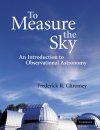![To Measure the Sky To Measure the Sky]()
Click to have a closer look
About this book
Contents
Biography
Related titles
About this book
To Measure the Sky introduces the fundamental topics in optical observational astronomy for undergraduates. Focusing on the basic principles of light detection, telescope optics, coordinate systems and data analysis, students are introduced to modern astronomical observation techniques and measurements. Cutting-edge technologies such as advanced CCD detectors and adaptive optics are presented through the physical principles on which they are based, helping students understand the power of modern space and ground-based telescopes, and the motivations and limitations of future development.
Contents
1. Light: particles, waves and rays, magnitudes, spectra
2. Uncertainty: statistics
3. Place, time and motion: coordinate systems, timekeeping, proper motion
4. Names, catalogs, atlases and databases: web resources
5. Astronomical optics: geometric optics, materials, cameras, fibers, aberrations
6. Telescopes: ground, space, ELTs, adaptive optics
7. Matter and light: atomic and molecular spectra, solid-state absorption
8. Detectors: CCDs, IR arrays, bolometers
9. Digital images from arrays: image processing, digital photometry
10. Photometry: extinction, standard systems
11. Spectrometry
Appendices
Index
Customer Reviews
Biography
Frederick R. Chromey is Professor of Astronomy on the Matthew Vassar Junior Chair at Vassar College, and Director of the Vassar College Observatory. He has almost 40 years experience in observational astronomy research in the optical, radio, and near infrared on stars, gaseous nebulae and galaxies, and has taught astronomy to undergraduates for 35 years at Brooklyn College and Vassar.
Textbook
Out of Print
By: Frederick R Chromey(Author)
380 pages, 187 b/w illustrations, 40 tables
"I like this book a lot and think it is a valuable contribution to the education of undergraduates. It is a wide-ranging and thorough survey of the techniques common to astronomical observing in the optical and infrared wavelengths [...] The treatment throughout is both accurate and responsible. I know of no comparable book."
- Jay M. Pasachoff, Williams College
"This is a wonderful book – one that at last introduces the essential ideas and techniques of observational astronomy starting at the 'ground floor', yet provides enough detail and mathematical rigor to satisfy the needs of sophisticated undergraduate physics majors (and their instructors). The writing throughout is literate – even enjoyable, yet Chromey introduces topics from Poisson statistics to solid-state detectors to modern image-processing techniques with an appropriate level of mathematical and physical rigor. There is more material here than can easily fit into a one-semester course, but the arrangement is such that an instructor can easily select the most appropriate topics for his/her students' needs. This is the textbook I've been waiting for. Bravo!"
- P. Frank Winkler, Middlebury College
"[...] I would highly recommend this book to anyone who is looking to develop their understanding of astronomical measurement. It is very well written, superbly produced and of high practical value."
- FAS Newsletter




































